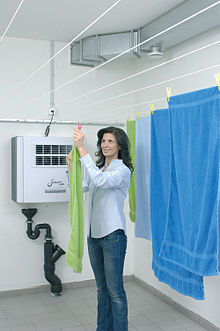
Back تجفيف Arabic Сушка Byelorussian Сушене Bulgarian Sušenje BS Assecatge Catalan Sušení Czech Trocknung German Ξήρανση Greek Secado de sólidos Spanish خشک کردن Persian

Drying is a mass transfer process consisting of the removal of water or another solvent[1] by evaporation from a solid, semi-solid or liquid. This process is often used as a final production step before selling or packaging products. To be considered "dried", the final product must be solid, in the form of a continuous sheet (e.g., paper), long pieces (e.g., wood), particles (e.g., cereal grains or corn flakes) or powder (e.g., sand, salt, washing powder, milk powder). A source of heat and an agent to remove the vapor produced by the process are often involved. In bioproducts like food, grains, and pharmaceuticals like vaccines, the solvent to be removed is almost invariably water. Desiccation may be synonymous with drying or considered an extreme form of drying.
In the most common case, a gas stream, e.g., air, applies the heat by convection and carries away the vapor as humidity. Other possibilities are vacuum drying, where heat is supplied by conduction or radiation (or microwaves), while the vapor thus produced is removed by the vacuum system. Another indirect technique is drum drying (used, for instance, for manufacturing potato flakes), where a heated surface is used to provide the energy, and aspirators draw the vapor outside the room. In contrast, the mechanical extraction of the solvent, e.g., water, by filtration or centrifugation, is not considered "drying" but rather "draining".
- ^ "drying - definition of drying by the Free Online Dictionary, Thesaurus and Encyclopedia". Farlex. Retrieved 23 April 2011.